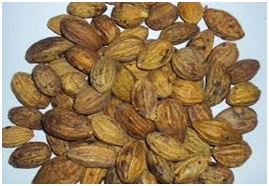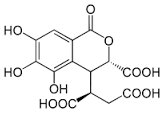Now You Know Natural Dyeing of Cotton Fabric Using Terminalia Chebula and Turmeric Part-4
Monday, 21 January 2019
Edit
NATURAL DYEING OF COTTON FABRIC USING TERMINALIA CHEBULA (KADUKKAI) AND TURMERIC (CURCUMA LONGA) PART-4
Rajan.S1
Textile Chemistry, SSM College of Engineering,
Komarapalayam, Namakkal, India.
srajusri321@gmail.com1
Gopinath.M2
Textile Chemistry, SSM College of Engineering,
Komarapalayam, Namakkal, India.
gopi.tc007@gmail.com2
Textile Chemistry, SSM College of Engineering,
Komarapalayam, Namakkal, India.
srajusri321@gmail.com1
Gopinath.M2
Textile Chemistry, SSM College of Engineering,
Komarapalayam, Namakkal, India.
gopi.tc007@gmail.com2
Previous Part
MATERIALS AND METHODS
Raw material
Terminalia Chebula (Kadukkai) and Turmeric (Curcuma Longa) was used as a raw material for the preparation of dye solution for dyeing.
 |
| Fig.01. Terminalia Chebula (Kadukkai) |
 |
| Fig. 02. Turmeric (Curcuma Longa) |
ABOUT TURMERIC (CURCUMA LONGA)
Turmeric is the most popular natural dye in textile dyeing. Turmeric is a rich source of phenolic compounds called curcuminoids. The active colouring ingredient in turmeric rhizome is Curcumin, which is also known as Natural Yellow. Its general formula is given in Figure.  |
| Fig.03. Chemical structure of turmeric (keto form) |
The common name of turmeric .This polyphenol compound due to a variety of biological activities has been gained significant attention of researches all over the world. Turmeric, an ancient colouring spice of Asia, as the main source of curcumin is traditionally used for many remedies. Curcumin due to a variety of specific characterizations as many other plant materials, there are differences in the curcumin content for the Curcumalonga from different geographical regions and it could be due to hybridization with other Curcuma species which could be important fact to choose the plant with higher content of curcumin. Curcuma longa rhizome has been traditionally used as antimicrobial agent as well as an insect repellent. Several studies have reported the broad-spectrum antimicrobial activity for curcumin including antibacterial, antiviral, antifungal, and antimalarial activities. Because of the extended antimicrobial activity of curcumin and safety property even at high doses (12 g/day) assessed by clinical trials in human, it was used as a structural sample to design the new antimicrobial agents with modified and increased antimicrobial activities through the synthesis of various derivatives related to curcumin . It was even studied as an antimicrobial agent suitable for textile materials. Results showed that curcumin in combination with aloe Vera and chitosan could be a potential suppressor for microbial growth in cotton, wool, and rabbit hair assessed by the exhaustion method .Either the continuous or batch dyeing process with curcumin provided textiles with antimicrobial properties beside the colour. Curcumin finished wool had semi durable antimicrobial activity, less durable to light exposure than home laundering with 45% and 30% inhibition rates against Staphylococcusaureus and Escherichia coli, respectively, after 30 cycles of home laundering . Mixture of curcumin with other antimicrobial agents is used for the development of antimicrobial skin gels and emulsions with improved skin protection and wound dressing properties. Composition of curcumin with hydrogel silver nanoparticles is used to increase the function of hydrogel silver Nano composites as marked substances for antimicrobial applications and wound dressing. Curcumin-loadedmyristic acid micro emulsion with the 0.86 μg/mL of curcumin suitable for skin consumption inhibited 50% of the S. epidermidis growth as one of the nosocomial infectious agents. It showed 12-fold strongerinhibitory effect compared to curcumin activity dissolved in dimethyl sulfoxide (DMSO).
TERMINALIA CHEBULA (KADUKKAI)
Terminalia chebula (Kadukkai)used as a mordant for cotton dyeing; it has good dye fixing properties. Cotton has very low affinity for natural dyes. Terminalia chebula (Kadukkai) plays an important role in cotton dyeing. It has phytoconstituents Such as chebulic acid, tannins, flavonoids, sterols, amino acids, fructose, resin, fixed oils etc.
 |
| Fig.04. Chemical structure of Terminalia chebula (Kadukkai) |
- TANNINS-Protection from predation and pesticides.
- AMINO ACIDS-It is a good anti biotic & kills the microorganism or inhibits their growth.
- CHEBULIC ACID- This constitution has good healing properties like Antibacterial, Antifungal, Antiviral, Antioxidant, &faster wound healing property.
METHODLOGY
Selection of Fabric
↓
Pre processing
↓
Natural Scouring
↓
Natural Bleaching
↓
Natural Dyeing
↓
Pre processing
↓
Natural Scouring
↓
Natural Bleaching
↓
Related:
SELECTION OF FABRIC
Selection of material with regard to medicated product is mostly preferred to the comfort ness of patient. When a patient is dressed the material is in close contact with physical touch. The fabric should be 100% cotton or organic. Cotton free from toxins and irritants. Cotton have been commonly used as the material for medical textile as it absorbs perspiration quickly, thus allowing the material to be fine and dry. Thus the investigator selected 100% cotton fabric for the study keeping in mind that medical that material such as cotton fabric can control and cure various diseases without causing any side effects when combined with herbal extract when in close contact with skin.
PRE-PROCESSING
- The material is first wetted in cold water solution containing a natural mild detergent (10%) and left in this bath for 24 hours.
- The Scouring process was carried out in the solution containing 15% natural scouring agent at the boiling temperature for an hour and washed till the material brought to neutral PH.
- The scoured cotton fabrics are exposed to direct sunlight with use of a natural grass base and animal manure, which carries out the natural bleaching process.
- No chemicals are used in this process.
 |
| Fig 05. Natural Bleaching |
The dye was prepared by extracting turmeric powder from deionised water at neutral pH, at 95°C for 1.5 hours. The obtained Curcuma Longa extract solution (dye solution) had a yellowish colour.
DYEING PROCESS
Dyeing of cotton fabrics using traditional method, were dyed with the naturalcolouring matter extracted fromTerminalia Chebula (kadukkai) and turmeric as a mordant at goods to liquor ratio 1:40, at 60°C, for 60 min. Dyeing was performed in stainless-steal beakers carried out. The fabric samples were immersed in the dyeing solution ina water bath at 40 °C. After dyeing, rinsing of samples was per- formed in warm and cold deionised water. The samples were air-dried at room temperature.
 |
| Fig 06. Natural Dyeing |
Sumber http://textilelearner.blogspot.com




